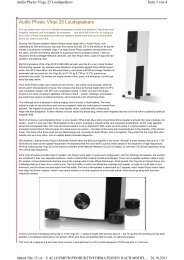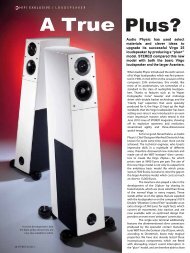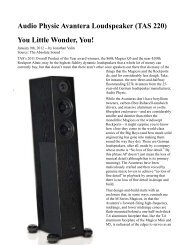Paradigm Atom Monitor v.7 Loudspeakers
Paradigm Atom Monitor v.7 Loudspeakers
Paradigm Atom Monitor v.7 Loudspeakers
You also want an ePaper? Increase the reach of your titles
YUMPU automatically turns print PDFs into web optimized ePapers that Google loves.
<strong>Paradigm</strong> <strong>Atom</strong> <strong>Monitor</strong><br />
<strong>v.7</strong> <strong>Loudspeakers</strong><br />
<br />
15 Sep 11<br />
Written by Doug Schneider<br />
The <strong>Atom</strong> has long been one of the most important models in <strong>Paradigm</strong>’s line: it’s their<br />
least-expensive main speaker -- almost anyone can afford it -- and it’s the gateway to<br />
<strong>Paradigm</strong>’s “house sound.”<br />
I was introduced to the <strong>Atom</strong> in the 1990s -- the v.2 edition -- and the last one I<br />
reviewed was the v.5, in 2007 (for GoodSound!), the year “<strong>Monitor</strong>” was added to the<br />
model’s name. Prior to v.5, the speaker was called the Performance <strong>Atom</strong>. <strong>Paradigm</strong><br />
discontinued the Performance series but wanted the <strong>Atom</strong> to live on, and so<br />
incorporated it into the <strong>Monitor</strong> series. There was an <strong>Atom</strong> <strong>Monitor</strong> v.6, but we didn’t<br />
review it; it seemed to be only a minor upgrade of the v.5, and cosmetically they looked<br />
about the same.<br />
Although the <strong>Atom</strong> <strong>v.7</strong>’s cabinet size, number of drivers, and low price ($398 USD per<br />
pair) are in line with the <strong>Atom</strong>s of yore, it’s a different animal: On its front baffle are two<br />
entirely new drivers that look very tech-y, and include technology trickled down from<br />
<strong>Paradigm</strong>’s far more expensive Studio series, as well as some things unique to this<br />
newest generation of the <strong>Monitor</strong> models.<br />
Description<br />
First, the <strong>Atom</strong> <strong>Monitor</strong> <strong>v.7</strong>’s cabinet: It’s made of 0.75"-thick MDF all around, and feels sturdy. It measures about<br />
11"H x 6.5"W x 9"D, weighs some ten pounds, and has a single set of binding posts on the rear. Commensurate with<br />
its low price, the <strong>Atom</strong> <strong>Monitor</strong> is still veneered in vinyl, not real wood or some other fancy finish. My review pair came<br />
in Black Ash, which is finished well, looks decent enough, and will blend easily into almost any décor. But if I were<br />
buying these, I’d opt for the other finish, Heritage Cherry, which looks a lot nicer and sticks out in a room more,<br />
something I like a speaker to do.<br />
More interesting is the way the <strong>Atom</strong> <strong>v.7</strong>’s baffle is made. A slab of MDF is recessed about half an inch, so that the<br />
top, bottom, and side panels form a lip. The drivers are screwed into the baffle, over which is snugly fitted (no rattles)<br />
a half-inch-thick plastic “fascia” with an attractive rubberized finish. This not only conceals the drivers’ baskets and<br />
screws, it provides a very smooth surface for the drivers’ wave launches, which should greatly reduce diffraction<br />
effects and result in smoother frequency response. Embedded in the plastic baffle are magnets, to which can be
attached the supplied grille. If you pull hard enough, you can remove this plastic cover, but I don’t recommend doing<br />
so unless you’ve got a good reason to get at the drivers (i.e., to repair or replace them, but not merely to see what’s<br />
back there).<br />
The <strong>Atom</strong> <strong>v.7</strong>’s drivers seem a clear step up in terms of both performance and appearance -- the midrange-woofers in<br />
the v.5 and v.6 models were tinted in a way that brought one word to mind: condom. The <strong>v.7</strong>’s silver-colored,<br />
ferrofluid-cooled, 1” dome tweeter is surrounded by a shallow waveguide and covered by a protective mesh. The 5.5”<br />
silvery-white midrange-woofer has a black rubber surround, a glass-reinforced polymer chassis, a high-temperature<br />
voice-coil for increased power handling, and a rear-firing port. Both driver diaphragms are made of <strong>Paradigm</strong>’s<br />
proprietary satin-anodized pure aluminum (S-PAL), and are crossed over at 2kHz using second-order electroacoustic<br />
slopes. Such a lowish crossover frequency ensures a good acoustic blend of the drivers’ outputs, both on and off the<br />
listening axis.<br />
<strong>Paradigm</strong> makes hardcore, audiophile-grade speakers, and provides more relevant specifications than do many<br />
manufacturers that offer speakers in this price range, particularly in terms of frequency response. The <strong>Atom</strong> <strong>v.7</strong>’s onaxis<br />
FRs are a claimed 86Hz-22kHz, +/-2dB -- or, from 30° off axis, 86Hz-18kHz, +/-2dB. The <strong>v.7</strong>’s stated lowfrequency<br />
extension is 50Hz (presumably the -10dB point), which is very respectable for so small a speaker. These<br />
specs indicate that the <strong>Atom</strong> <strong>v.7</strong> has been designed to generate quite deep bass for its size, and to sound very linear<br />
(i.e., neutral) over a wide listening window. Other useful specs provided: impedance, said to be “Compatible with 8<br />
ohms,” meaning not exactly 8 ohms, but still easy enough to drive; sensitivities of 90dB in-room and 87dB anechoic<br />
(i.e., about average); and amplifier power, which <strong>Paradigm</strong> recommends should be between 15 and 80W.<br />
Setups<br />
No one will use the <strong>Atom</strong> <strong>Monitor</strong> <strong>v.7</strong> as I did for some of my listening sessions: with a high-grade, high-powered amp<br />
such as Bryston’s 4B SST 2 in a super-high-end system (see “Associated Equipment,” below). I wanted to find out how<br />
well this speaker could perform in such a context, and figured that readers would want to know too. More sensibly, I<br />
also partnered the <strong>Atom</strong> <strong>v.7</strong> with an Audioengine N22 integrated amplifier (22Wpc into 8 ohms, $199) fed by an iPod<br />
Touch. Between these two extremes lies any imaginable combination of source component and amplification. In both<br />
systems, the <strong>Atom</strong> <strong>Monitor</strong>s <strong>v.7</strong>s were perched atop 24"-high stands.<br />
Sound<br />
My reference loudspeaker is Revel’s statement-grade Ultima Salon2 ($22,000/pair). While listening to the <strong>Atom</strong><br />
<strong>Monitor</strong> <strong>v.7</strong>, I was also preparing my review of Vienna Acoustics’ impeccably built and uniquely voiced Mozart Grand<br />
SE speaker ($3500/pair). How was a little $398 pair of speakers supposed to stand up to either of those, let alone<br />
sound impressive in any way?<br />
Surprisingly, the little <strong>Atom</strong> <strong>v.7</strong>s did impress me. One of the most remarkable things about them was the large,<br />
spacious soundfield they produced, something you don’t necessarily expect from a small speaker at such a low price.<br />
The little <strong>Atom</strong>s had no trouble filling with sound even my large listening room -- nor, much to my surprise, did I hear
any port chuffing or other objectionable sounds when I turned the volume up quite loud. My smaller room, where my<br />
Audioengine N22 amp resides, is more the size of room the <strong>Atom</strong> is intended to be used in; there, the pair of them<br />
sounded extremely full and very alive.<br />
The bass weight was excellent for so small a speaker -- I got good reach to about 50Hz, which is great for a 5.5” driver<br />
in a small box -- and the tightness and control were outstanding. When I played the title track of Bruce Springsteen’s<br />
Tunnel of Love (CD, Columbia CK 42000), the drums had surprising depth and punch. The heavy drumbeats<br />
throughout the opening of “Rolling in the Deep,” from Adele’s 21 (CD, XL Recordings 44699), were re-created<br />
surprisingly well. The <strong>Atom</strong> <strong>v.7</strong>’s combination of depth, tightness, and control in the bass is a great improvement over<br />
the v.5’s performance in that region; while also producing full-sounding bass, the v.5 could sound a bit loose and<br />
woolly down low, particularly when pushed hard.<br />
If, to get a more full-range sound, you wanted deeper bass (i.e., closer to 20Hz) than the <strong>Atom</strong> <strong>v.7</strong> can provide, you’d<br />
have to add a subwoofer, particularly if you wanted to use them for movies -- small speakers may sound impressive<br />
for their size, but their bass can go only so deep. (Of course, you could instead get one of <strong>Paradigm</strong>’s larger <strong>Monitor</strong><br />
models.) But I think that listeners who aren’t bass freaks will find that the <strong>Atom</strong> <strong>v.7</strong> sounds robust enough in a room of<br />
small to medium size. I did.<br />
Like its predecessors, the <strong>Atom</strong> <strong>v.7</strong> had an even overall tonal balance that made voices and instruments sound<br />
completely natural. Reviewer Philip Beaudette dropped by and listened to some of the tracks from 21. “They get<br />
Adele’s voice exactly right,” he declared, and I agreed. But it wasn’t only Adele’s voice -- the <strong>v.7</strong> got right every voice<br />
and instrument I listened to through them. Still, this didn’t exactly shock me. <strong>Paradigm</strong> has always made neutralsounding<br />
speakers -- their designs have long adhered to the research done at Canada’s National Research Council in<br />
the 1980s, which called for speakers to exhibit relatively flat on- and off-axis frequency responses. The result is very<br />
natural sound, not only for listeners sitting directly in front of the speakers, but also for those sitting well outside the<br />
“sweet spot,” and in almost every point of the room.<br />
I believe the <strong>Atom</strong> <strong>v.7</strong>’s excellent dispersion characteristics account for the speakers’ spacious sound. But if the <strong>v.7</strong><br />
faltered in one area, it was in the precision of the soundstage -- the lateral spread of the soundstage was awesome,<br />
and had a decent illusion of depth, but the stage itself wasn’t as focused as through some other speakers. I suspect<br />
that is one of the tradeoffs of creating such an impressive sense of space. For 400 bucks, you can’t have everything.<br />
The <strong>Atom</strong> <strong>v.7</strong> seemed to be voiced quite differently from its predecessors in the highest frequencies. I often found the<br />
early <strong>Atom</strong> models to be ever-so-slightly reticent up top, and often thought that was a deliberate design choice to<br />
ensure that their inexpensive tweeters would never sound unruly or bright, and/or to cover up the flaws of the lowpriced<br />
electronics the speakers would likely be used with -- cheap amps can sound hard, edgy, or bright, and a soft<br />
top end can help tame that. The <strong>Atom</strong> <strong>v.7</strong> had nothing resembling a high-frequency rolloff. If anything, there was more<br />
energy up top than I’m used to hearing from <strong>Paradigm</strong> speakers. Still, while the <strong>Atom</strong> <strong>v.7</strong> didn’t sound bright, it sure<br />
sounded lively up high -- the top end of a guitar’s sound really shimmered, and cymbals, while clean, were quite<br />
prominent.
In one area, the <strong>Atom</strong> <strong>v.7</strong> floored me: its re-creation of the sound of the acoustic piano. To assess how well a speaker<br />
does this, I use Glenn Gould’s A State of Wonder: The Complete Goldberg Variations of J.S. Bach 1955 & 1981 (CD,<br />
Sony Classical 87703); and Ola Gjeilo’s Stone Rose (CD/SACD, 2L 2L-048-SACD). The <strong>Atom</strong> <strong>v.7</strong>’s top end was<br />
prominent, but never excessive or bright; instead, its superb clarity up top made the instrument sound really alive.<br />
Mostly, though, it was the low end of Gjeilo’s piano that took me aback -- it sounded fuller and richer, with more detail,<br />
than I ever thought so small a speaker could manage. I don’t want to overstate the <strong>Atom</strong> <strong>v.7</strong>’s bass output -- it’s<br />
definitely not a full-range design -- but I don’t want to understate it either: this pintsize speaker sounded robust.<br />
With the Goldberg CD, it wasn’t the fullness or richness of the bass but, instead, the way the <strong>Atom</strong> <strong>v.7</strong> revealed the<br />
incisiveness and attack of Gould’s rapid-fire playing. The <strong>v.7</strong>’s sound was so detailed and well articulated that I’m sure<br />
most people unaware of its price would think they were hearing a set of larger speakers costing well over a grand. The<br />
<strong>Atom</strong> <strong>v.7</strong> offered so much music for so little money -- something I can’t always say about the really expensive stuff. I<br />
was impressed.<br />
Comparisons<br />
It was interesting to replace the Audioengine P4 speakers ($249/pair) in my smaller system with the <strong>Atom</strong> <strong>Monitor</strong><br />
<strong>v.7</strong>s. The jury is out on which speaker looks better -- the P4’s rounded edges and bamboo finish give it a unique look -<br />
- but there’s no question that the <strong>Atom</strong> <strong>v.7</strong> is more substantially built. The <strong>v.7</strong>’s cabinet is at least 20% bigger, its<br />
woofer is at least 1” larger in diameter (which, with the bigger cabinet, means deeper bass), and both drivers look<br />
more advanced and high-tech. That’s not to dis the P4 -- it costs more than a third less than the <strong>Paradigm</strong>, and it’s<br />
intended to be used in a bedroom, living room, or office. In an office, it’s likely to be used on a desk, where its smaller<br />
size and unique appearance will be more welcome than the bigger, boxier <strong>Atom</strong> <strong>v.7</strong>.<br />
The two models’ sound qualities are also markedly different. The P4 is notable for sound that is very neutral and<br />
refined for the price -- for $249/pair, it’s a very good deal. But for $149 more, the <strong>Atom</strong> <strong>v.7</strong> offers a bigger, richer, fuller<br />
sound, with far more impact in the bass, even when driven by the little 22Wpc N22 amp. And in terms of spaciousness<br />
there was no contest -- the P4s’ sound was always easily identified as emanating from and slightly around the<br />
speakers’ cabinets, whereas the <strong>Paradigm</strong>s’ sound seemed to come from everywhere but the cabinets. The P4’s<br />
highs sounded clean, but the <strong>Atom</strong> <strong>v.7</strong>’s highs were far more clear, extended, and lively. My wife listens to a lot of<br />
guitar-dominated Latin music through our second system, and there was no question that plucked guitar notes<br />
sounded much cleaner and more refined through the <strong>Atom</strong>s. In fact, after the <strong>Paradigm</strong>s had been in the system a<br />
while, she didn’t want me to remove them. The <strong>Atom</strong> <strong>v.7</strong> also rendered voices and subtle details with much more<br />
clarity.<br />
If you can’t spend more than $250, or just want some decent-sounding, nice-looking speakers for your desktop, the P4<br />
is a good choice. But moving up to the <strong>Atom</strong> <strong>Monitor</strong> <strong>v.7</strong> offers a significant improvement in sound quality and gets<br />
you into the territory of real speakers -- speakers around which you can build a true high-end system.<br />
The Polk RTi A1 loudspeaker, which Aron Garrecht reviewed and praised last year, is one of those real speakers, and<br />
proved a more worthy opponent. I have a pair of them here and can back up Aron’s enthusiasm with my own -- the
RTi A1 is not only a great sonic value for the price ($340 when Aron reviewed them), it gets high points for its fine<br />
appearance, particularly its curved side panels. I remember getting them here and being more impressed with their<br />
appearance than with the <strong>Atom</strong> <strong>Monitor</strong> v.5’s. The two speakers’ drivers are about the same size, but the <strong>Paradigm</strong>’s<br />
cabinet is a little smaller.<br />
There were some sonic similarities. Mostly, the speakers shared a generally neutral overall tonal balance with a slight<br />
rise in the top end, and more-than-respectable bass extension for their sizes. It didn’t take long, though, to hear that<br />
time had marched on: despite being slightly smaller than the Polk RTi A1, the new <strong>Atom</strong> is the new boss.<br />
The RTi A1’s tipped-up top end sounded so bright and edgy with “Take It All,” from Adele’s 21, that I had to<br />
keep turning the volume down. The <strong>Atom</strong> <strong>v.7</strong>’s highs were just as prominent but were always clean, never<br />
bright or edgy -- I could play this track louder without listening fatigue. Through the Polk, Adele’s voice also<br />
sounded a bit wispy, with a slight papery quality that overemphasized some sibilants; the <strong>Atom</strong> <strong>v.7</strong> never did<br />
this. The <strong>Paradigm</strong> also sounded slightly fuller and richer in the midrange, and delivered slightly deeper bass<br />
that also seemed to be more accurate -- piano and drums sounded far more real.<br />
Aron was right -- the RTi A1s can image precisely, hanging well-defined voices and instruments clearly and<br />
on the soundstage. That impressed me. But the <strong>Atom</strong> <strong>v.7</strong>s stepped ahead of the RTi A1s in creating a better<br />
sense of overall space -- a far wider, slightly deeper soundstage -- and revealing details around the musicians<br />
that were simply lost through the Polks.<br />
The Polk RTi A1 is a better speaker than the Audioengine P4, but the <strong>Paradigm</strong> <strong>Atom</strong> <strong>Monitor</strong> <strong>v.7</strong> is better<br />
than either. If your No.1 priority is sound and your budget can stretch to include $398, then of these three<br />
models, the <strong>Atom</strong> <strong>v.7</strong> is the one to get. There’s not always a direct correlation with price and performance; in<br />
this case, there is.<br />
Conclusions<br />
Many have compared <strong>Paradigm</strong> to Honda in terms of reputation, build quality, and value; like Honda’s Civic, some of<br />
<strong>Paradigm</strong>’s inexpensive speaker models -- such as the <strong>Atom</strong> <strong>Monitor</strong> <strong>v.7</strong> -- are low-priced portals to more expensive<br />
offerings. This is quite a compliment in both directions; both companies are well respected. Recently, though,<br />
Consumer Reports considerably downgraded its recommendation of the Civic because the 2012 model didn’t perform<br />
as well as those of previous years. That was a shock to some, who wondered how Honda could have missed the mark<br />
by so much.<br />
With the <strong>Atom</strong> <strong>Monitor</strong>, <strong>Paradigm</strong> hasn’t suffered that fate. I’ve been familiar with the model’s various iterations over<br />
many years, and can unequivocally say that, overall, the <strong>v.7</strong> is the best one yet. Its vinyl-clad cabinet is reminiscent of<br />
yesteryear’s designs -- nothing special there -- yet the speaker looks better than before. This is partly due to the nicelooking<br />
grille design, but mostly to the fact that when the grille comes off, it reveals an attractive baffle with a clean,<br />
high-tech appearance and sharp-looking drivers. Most important, the speaker sounds remarkably robust in the bass<br />
for its size, exceedingly natural from the upper bass through the mids, and lively but extremely clean in the highs. All
told, <strong>Paradigm</strong>’s <strong>Atom</strong> <strong>Monitor</strong> continues to be one of the best deals in high-end audio, and the highest-value entry<br />
point in the company’s vast speaker line. Very highly recommended for those looking for a lot of music for very little<br />
money.<br />
. . . Doug Schneider<br />
das@soundstagenetwork.com<br />
Associated Equipment<br />
<br />
<br />
<br />
<br />
<br />
<br />
<br />
<br />
Speakers -- Revel Ultima Salon2, Vienna Acoustics Mozart Grand SE, Audioengine P4, Polk Audio RTi A1<br />
Amplifiers -- Bryston 4B SST 2 , Audioengine N22<br />
Preamplifiers -- Simaudio Moon 350P, Lamm LL2.1 Deluxe<br />
Digital sources -- Simaudio Moon Evolution 650D DAC-transport, Ayre Acoustics QB-9 USB DAC, Hegel<br />
HD10 DAC, Sony Vaio laptop, iPod Touch<br />
Digital converters (USB to S/PDIF) -- Blue Circle Audio USB Tunnel, Stello U3<br />
Digital interconnects -- AudioQuest Diamond USB, i2Digital X-60 coaxial<br />
Analog interconnects -- Nirvana S-L, Nordost Quattro Fil<br />
Speaker cables -- DH Labs Silver Sonic Q-10 Signature, Nirvana S-L, Nordost Valkyrja, Audioengine generic






